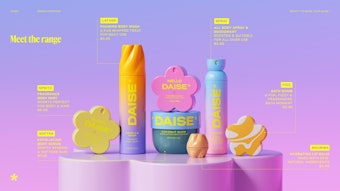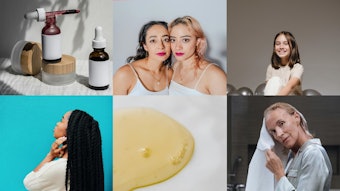The term “nutricosmetic” has not generated the same buzz as “natural” and “green”—yet. However, it is, in many ways, also a segment that parallels naturals, and the development of the segment will likely make comparisons to the flourishing natural segment even clearer.
Once a term not widely associated with the beauty segment, though quite familiar in the food and beverage arenas, naturals have shed a somewhat cult status to become a label widely accepted and sought after by a growing number of mainstream consumers. “Natural,” and related words such “green,” have become both immediately recognizable and graspable by consumers in the context of beauty products—though, arguably, incredibly confusing terms in this same context—and enthusiastic media coverage, and growing concerns about product safety and healthier lifestyles, in general, have helped foster the consumer drive toward these labels.
Market data demonstrates that nutricosmetics, too, is gaining ground with consumers concerned over health and wellness issues and those who generally view beauty as part of that concept. In fact, products in both segments comfortably serve the more encompassing trend in which consumers opt for any product that is deemed beneficial toward health and wellness lifestyles, as noted in the September 2008 GCI magazine feature on Page 39, “Nutricosmetics: A New Way to Beauty.” Health and wellness encompass underlying desires for both natural offerings and nutricosmetics, and parlay into the now familiar and widespread “beauty from the within” concept, which bodes well for the dollar value of nutricosmetics. The current market for the segment, according to Euromonitor International, is relatively small at $2.1 billion, accounting for 3% of the $66 billion skin care market in 2007. However, whether a supplement or a beverage/food, the nutricosmetic offers enormous potential. The vitamin and dietary supplement market is currently valued at $56 billion, and a Global Industry Analysts’ 2007 report on functional foods forecasts the functional food and beverage market to reach $109 billion by 2010—making for a very attractive line expansion option for beauty brands.
While considering how nutricosmetics may fit into their portfolios, beauty brands are fortunate to be able to travel down a road already paved by the food and beverage industry. Even the potholes, such as regulatory issues, have been mapped. This does not mean, however, that considerations for a nutricosmetic product, whether a supplement or a food/beverage, and the process for getting it onto shelves should be taken lightly.
As noted in “Eat and Drink Your Skin Care,” marketing claims, documentation and ingredients are all under regulatory scrutiny. Processes and packaging also fall under this scrutiny, and like R&D, packaging and processing may be best left to a partner well-versed in the food and beverage market.
“The most immediate issue [for beauty brands introducing ingestible products] would be regulatory issues,” says Marcelo Ferrer, category manager, beverage systems, Tetra Pak—a food processing and packaging solutions company operating under the mission of making food safe. “Is the product going to be FDA regulated or just fall to Good Manufacturing Practices? In personal care manufacturing, especially the large multinationals, equipment is sanitized and cleaned much like you would see in a food plant—sometimes to an even higher degree of protection, to protect the brand. I would say, though, that if cosmetic producers are really considering doing this, the best thing to do is partner up with someone, much like L’Oréal is doing with Coca-Cola, or get someone on board who comes from the food industry, because—even though the equipment and sanitary standards are somewhat similar—the processing requirements and the regulatory are very different.”
Scott-Vincent Borba, creator and founder of BORBA, began his foray into ingestible skin care with the launch of nutricosmetic waters. His company recently introduced gummi bear boosters that contain a cultivated bio-vitamin complex formulated to help skin regenerate its natural support system by increasing the potential to absorb skin care ingredients into the epidermis, and positioned as dietary supplements. “Dealing with [beauty] products meant for ingestion is a whole different league,” says Borba. “It’s dealing with FDA and FTC (Federal Trade Commission) requirements, which a lot of cosmetic companies don’t really get into because they are really talking about structure function claims. For a company that’s a traditional cosmetics company trying to get into [the nutricosmetic segment], they take on significant challenges and liabilities if they are not taking into consideration that the product must not only be efficacious but true to the claims that it states—as well as meet the minimum FDA and FTC objectives when it comes to function.”
Partnering with an experienced food and beverage company allows some processing hurdles to be more easily crossed, but there are caveats.
“From a manufacturing perspective, manufacturers of [nutricosmetics] that are not used to beauty marketers or biochemists or estheticians coming to them saying, ‘okay, I want to create something,’ are typically manufacturing from a traditional food perspective,” says Borba. “When they are asked to put in this extract or this ingredient, they don’t typically have the R&D capacity or sourcing capacity to get some of these radical new nutrients or delivery systems or extracts—or even understand the importing procedures that it takes to get these products put together. “And there are already certain manufacturing machinery that’s been built for the traditional types of products they make, and usually beauty companies want something more unique and different—a little bit cooler or offers something a bit better in the delivery system of the packaging,” he adds. “So, that opens up another huge challenge; it’s even a challenge for a company to outsource those requirements. There’s probably 100 times more complexity in trying to tap into [the nutricosmetic segment] if you don’t have any equity tied to the brand within the segment. If you’re known for color cosmetics or topical products, even for traditional herbal supplements, to really have equity and consumer loyalty behind you is difficult unless you really know what you’re doing. There is still a challenge in breaking through to find consumer loyalties to new products.”
All About pH
For products intended for ingestion, particularly beverages, the pH level must be regarded because of its impact on what type of microorganisms may grow in the product and, therefore, on how a product can be processed and shipped, its shelf stability and the degree of regulatory scrutiny it is under.
“If you’re talking about a high-acid beverage—those with a pH lower than 4.6—you only have certain types of bacteria or microorganisms that can live in the product,” says Ferrer. “Generally speaking the high acid products are somewhat straightforward when it comes to pasteurization. From a regulatory standpoint, you don’t have a whole lot of scrutiny. Basically, manufacturers who follow Good Manufacturing Processes should be okay because the product is safe due to the pH.”
As noted in both “Eat and Drink Your Skin Care” and “Nutricosmetics: A New Way to Beauty,” dairy is one of the most accessible and advantageous avenues of brand expansion (expected by Global Industry Analysts to reach $34 billion by 2010), but it also requires the most consideration throughout processing and delivery to shelves.
“Any low acid product, pH 4.6 or higher is where regulatory really starts to be stringent,” says Ferrer. “You have FDA involved, and you really have to have a scheduled process—and underwrite the process. Distribution really needs to be considered with these products. Is it going to be chilled all the way to the consumer? The biggest consideration in distributing is the pH of the beverage. Then you have to see who’s going to regulate it. There is a strong regulatory demand on low-acid products, because if you do have a bacteria growth or contaminant, you could potentially have bacteria that will cause a lot of harm to consumers. These are bacteria that could even kill people.”










